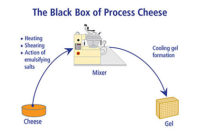Understanding the basics: Techniques to attain a high cheese yield
To attain a high cheese yield, cheesemakers need to retain as much casein, fat and moisture as possible. Here are some techniques.

In an ideal world, all solids in the cheese vat would end up in the finished product. Unfortunately, this is not possible with our current cheesemaking methods. Therefore, cheese yield has become a way to define the percentage of moisture, casein and fat in milk that actually converts into cheese. Since high retentions of moisture, casein and fat equal a high cheese yield and high economic gain, the goal is to retain as much protein, fat and moisture as possible, while ultimately producing a cheese with the desirable quality attributes.
Cheese yield prediction
A cheese yield prediction equation describes the relationship between the concentrations of fat and casein in milk and the amount of cheese that can (in theory) be produced from that milk. This prediction equation includes factors for fat recovery and casein losses, as well as the retention of other solids like whey proteins and salt. Although the calculation is quite simple, reaching that optimum cheese yield and retention rate is not.
Consider for example that a one-point decrease in casein retention can translate into a loss of almost .05 pounds of cheese per every 100 pounds of milk. Additionally, typical fat recoveries for Cheddar average around 92% and casein recovery is often around 95%, but different recoveries can occur industrially due to the actual processing conditions used for cheesemaking.
Improving fat, casein retention
A processor can accomplish improved retention in a few ways, but one of the most popular involves updated vat designs/equipment. Since most of the loss of milk solids occurs while the cheese is still in the vat, utilizing a vat that minimizes protein and fat losses during cutting can help keep solids retention high. By utilizing a modern enclosed vat design with horizontal agitation, cheesemakers can achieve < 0.2% fat in the whey. In our experience, most older open vats only achieve whey fat levels of ~0.4%. Casein losses can also be minimized by modern vat designs.
Since casein loss is generally due to the production of cheese fines during cutting or by the creation of glycomacropeptide during coagulation of the milk, utilizing an alternative vat system that minimizes damage during cutting can help to avoid these casein losses. An alternative cheesemaking approach involves using a continuous production method like a belt system. This system allows for gentler cutting and handling processes, thus improving the retention of fat and casein. To date, this approach has been popular with high-moisture cheeses, like feta. New versions of the belt system are in development for other cheese varieties.
Standardizing cheesemilk
Another way to increase yield, as well as keep yield consistent throughout the year, is to add more milk solids to the cheese milk. Historically, cheesemakers just standardized to a specific fat content or to a fat-to-protein ratio. However, from season to season the concentrations of fat, protein and casein in milk varies, which induces variability in the cheese process and thus, negatively impacts cheese quality.
Standardization of cheesemilk to a specific (and constant) casein and fat level would help significantly reduce variability in the cheesemaking process, thus creating more consistent coagulation and acidification profiles. More consistent cheese composition also equals more consistent product quality.
Using microfiltration
In recent years, use of microfiltration of milk has been advocated since it offers higher quality whey products than traditional whey produced from cheesemaking. For cheese varieties with a federal standard of identity, the use of microfiltered cheesemilk may not be possible due to regulations that dictate which type of cheesemilk solids can be used. In fact, while control of casein content via microfiltered milk addition is allowed in most countries, the U.S. regulations have not yet caught up with these new research innovations.
In addition to reducing casein loss, innovators are also interested in finding ways to put whey protein back into the cheese. The majority of whey proteins (>96 %) are lost in the whey stream. Many plants process these proteins into valuable by-products (like whey protein concentrate) to create an additional financial return for the cheese plant.
If a company does not have a significant whey processing business, however, it may be worth investigating a process called microparticulation. Microparticulated whey
protein can boost moisture levels in cheese, which aids in increasing yield and helps to create a smoother texture.
Future innovations
Researchers and the dairy industry are also looking towards the future by collaborating on potential innovations. This includes better sensors that monitor when cutting should commence, and technologies that would allow cheesemakers to have better control of curd moisture during the cheesemaking process.
Looking for a reprint of this article?
From high-res PDFs to custom plaques, order your copy today!








